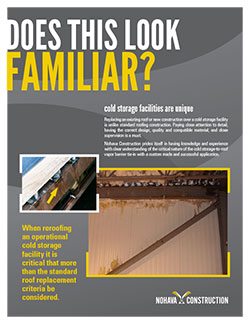Cold storage
We Have Hot Solutions For Cold Storage.
Moisture-related damage in cold storage buildings can vary from minor exterior or interior staining, to complete failure of the building enclosure. Here are two primary types of cold storage facilities: detached and attached and their possible condensation issues.
Attached Facilities
Condensation problems in attached cold storage areas are typically more likely to affect the adjacent spaces. A relatively common problem can occur when refrigerated rooms are inadequately insulated, resulting in condensation and possible microbial growth on their exterior surfaces, as well as on the interior surfaces of the adjacent spaces.
Detached Facilities
A detached cold storage building requires the designer to think backwards, the warm side is now the cold side; cold air sinks instead of hot air rises; and a primary goal of the enclosure is to keep warm air out during both the winter and summer. Failure to follow these general guidelines can result in a variety of condensation problems. Insufficient insulation in exterior walls and roofs can result in cold spots on the exterior of the building. The consequences of insufficient insulation can range from increased energy use to condensation or even frost formation on exterior surfaces. Thermal bridging through refrigerated enclosures is less of a problem in buildings that use continuous insulated panels as either the exterior walls or as a component of those walls.
Questions to consider…
- What is your roof system?
- What is the condition of the insulation and how much do you have?
- Are there thermal leaks in the present insulation strata?
- Do you have vapor leaks?
- Is your roof UL or FM rated?
- What is your deck type?
